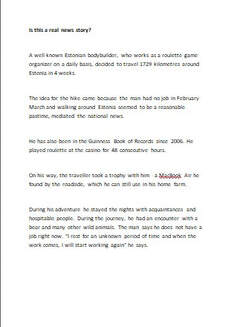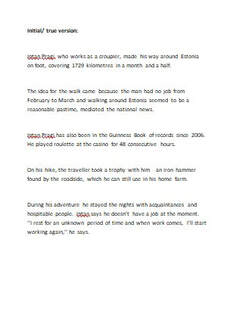PLAN
Our target age range
13-16 years
We wanted to:
Develop critical thinking skills and to raise awareness on fake news on media.
Demonstrate how a news story can be manipulated and distorted.
Demonstrate how a news story can be manipulated and distorted.
We chose to:
Find an obscure online news story.
Choose one which is not too long and not too short.
Discuss and decide how to change parts of the story, so some of it remains true but other facts are altered.
Make sure both stories are ready to share.
Proof read.
Choose one which is not too long and not too short.
Discuss and decide how to change parts of the story, so some of it remains true but other facts are altered.
Make sure both stories are ready to share.
Proof read.
DO
What do I need?
Two versions of the news story - the original story and the changed version (Word document)
| is_it_true_stories.docx | |
| File Size: | 25 kb |
| File Type: | docx |
How long does it take?
Preparation: 60 minutes
Delivery: about 20 minutes
This activity is not to cover the whole lesson. It can be used as part of the lesson or as a stimulus for bigger discussion.
Delivery: about 20 minutes
This activity is not to cover the whole lesson. It can be used as part of the lesson or as a stimulus for bigger discussion.
How it works
Present your manipulated story to the group. Provide them with copies to read.
Explain that they need to decide which parts of the story might be true and which parts might be false - and why they think this.
Organise your participants into groups of 6, to read and discuss the story. They need to justify their decisions.
Bring the whole group back together to share their ideas and reasoning about which aspects of the story are true or false.
Explain that they need to decide which parts of the story might be true and which parts might be false - and why they think this.
Organise your participants into groups of 6, to read and discuss the story. They need to justify their decisions.
Bring the whole group back together to share their ideas and reasoning about which aspects of the story are true or false.
REVIEW
How it ends
Read out the original news story with the group.
How accurate were their judgments of the manipulated story?
Discuss:
How accurate were their judgments of the manipulated story?
Discuss:
- Is it easy to spot fake news?
- Why are fake news stories so deceptive?
- How can truth be defined?
- Is truth the same for everyone?
- Are manipulated stories just harmless fun?
Always ask your participants for feedback:
- Did they understand the task?
- What did they learn?
- What did they find easy or difficult, why?
- What did the student leaders do well?
- Where can the students improve?
- How could the activity be made even better?







